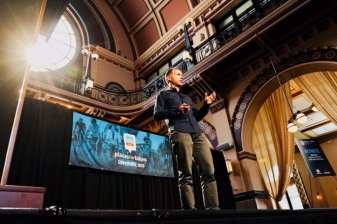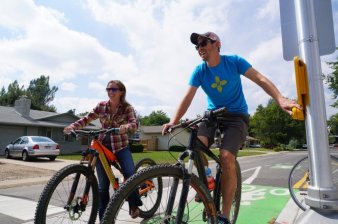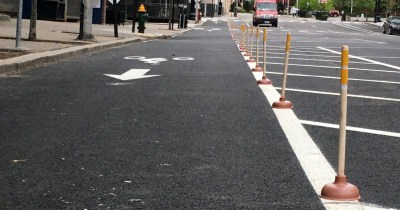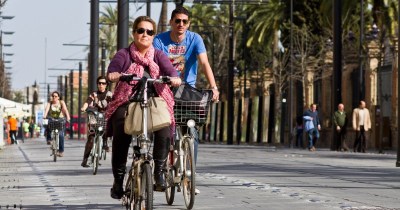Michael Andersen, PlacesForBikes
Recent Posts
Six Secrets From the Planner of Sevilla’s Lightning Bike Network
| | No Comments
Here's one way to understand the story of biking in Sevilla, Spain: It went from having about as much biking as Oklahoma City to having about as much biking as Portland, Oregon. It did this over the course of four years.
Lightning Fast, Dirt Cheap: Five Tips From SF’s Protected Bike Lane Projects
| | No Comments
How to cut the project time of a new protected bike lane by 90 percent and the cost by 75 percent.
Bikes and Transit Keep Racking Up Ballot Wins Across the Country
| | No Comments
In one U.S. city after another, voters keep making their opinions clear.
Fort Collins Just Built Five Miles of Bikeway for Less Than $1 Million – Here’s the Trick
| | No Comments
Fort Collins, Colorado, is the latest city to embrace America’s most underrated type of bike facility. As it works to improve the low-stress biking network in the newer, car-oriented neighborhoods of its northwest, the city of 164,000 has used a tool that can be perfect for quickly, cheaply linking up the biking grid: a neighborhood […]
Want People to Bike? Skip the Sweet Talk and Build
| | No Comments
Don't waste time trying to convince people to feel warmly about bicycling.
Study After Study Finds Latinos Have a Strong Affinity for Social Biking
| | No Comments
Most people find it pleasant to bike with people they know. But there's growing evidence that Latino Americans are particularly interested in social biking.
An Idea That Sticks: Another Plunger-Protected Bike Lane Goes Permanent
| | No Comments
Tactical urbanism projects are prompting cities to improve the bike-riding environment.
Here’s a New Street-Level Analysis of the Biking Networks in 299 U.S. Cities
| | No Comments
PeopleForBikes has just made the first attempt to measure and compare local bike networks on a nationwide scale.
Landmark Study Tests a Bike Network’s Effects on Safety and Ridership
| | No Comments
Fascinating results from a city whose bike network was literally a Communist plot.
Connecting Cities’ Scattered Bikeways Is Going to Be Harder, But Worth It
| | No Comments
When the low-hanging fruit has all been eaten, there's only one thing to do: climb higher.
Grassy Storm Drainage Can Be a Transportation Twofer, New Guide Shows
| | No Comments
If your city's transportation department and its stormwater management department were to team up to put storm drainage in just the right places, it could be a very cost-efficient way to manage runoff while creating permanent, attractive separation between bike and car traffic.

![PlacesForBikes is a PeopleForBikes program to help U.S. communities build better biking, faster. You can follow them on LinkedIn, Twitter or Facebook or sign up for their weekly news digest about building all-ages biking networks.
If you'd like to cut the project time of a new protected bike lane by 90 percent and the cost by 75 percent, Mike Sallaberry has some advice.
A senior transportation engineer for the San Francisco Municipal Transportation Agency, Sallaberry has a short piece in the new issue of ITE Journal sharing useful details on three projects in 2016 and 2017 that used the "quick-build" method. Instead of spending two years getting every detail right and then pouring permanent curbs, SFMTA built first -- using paint, plastic and removable concrete islands -- and asked questions both before and after.
The result, as Sallaberry explains, is a potentially more inclusive public process and a project that's far more efficient.
"Common practice in San Francisco has been to identify the ideal result then wait for design, funding, contracting and construction to deliver the design," says Sallaberry. "While this makes sense for many situations, a new approach was used recently where intermediate designs were implemented in the near term to act as 'stepping stones' to a longer term design."
Maybe most important, the inherent flexibility of the quick-build approach makes it institutionally easier for a public agency to innovate. Without so much "fear of installing something that does not work," Sallaberry explains, city staff feel free "to try new ideas to solve challenging issues."
The agile process recalls modern software engineering, so it's fitting that San Francisco is among the first cities embracing it. Here are five lessons we saw in Sallaberry's piece for other cities interested in becoming fast followers.
1) Get the whole team to sign a prenup.
[caption id="attachment_21304" align="alignnone" width="604"] Members of SF's quick-build project team. Photo: Jeremy Menzies, SFMTA[/caption]
Not a literal premarital agreement, of course, but the day-job equivalent of one. Sallaberry refers to the document his team used as "a project charter with roles and responsibilities, along with other key project details, clearly spelled out and signed off on by all pertinent staff."
The point of the "project charter," in Sallaberry's description, isn't so much to tie people's hands as to make it easier for people to improvise effectively during a fast-moving process.
"Just as one would not put five players on a basketball court without assigning positions, identifying their responsibilities, or having any plays in mind and expect much success, all players on the project team should know their roles and responsibilities from the start so that no tasks fall through the cracks or are replicated by more than one person," he writes.
2) If possible, make sure your city has policies that will help resolve difficult tradeoffs.
[caption id="attachment_21301" align="alignnone" width="604"] Division and 13th. Photo: Jeremy Menzies, SFMTA[/caption]
Sometimes you simply have to choose: should a project prioritize walking safety or automotive speed? Project timeline or stakeholder consensus? Sallaberry attributes some of his team's success to a city that had preemptively agreed on some of its key values.
He mentions San Francisco's "long-standing 'Transit First' policy that prioritizes transit, pedestrian and bicycle elements over the accommodation of single occupant vehicles"; "a Vision Zero policy signed off on by key city agencies to work toward a goal of zero traffic fatalities by 2024"; and "an executive directive by the mayor spelling out near term deliverables and timelines for agencies like the SFMTA to complete street safety improvements."
3) The question to ask stakeholders isn't "Should we do this or not?" -- it's "How should we do this?"
[caption id="attachment_21302" align="alignnone" width="604"] Photo: Mike Sallaberry, SFMTA[/caption]
Like a parent asking if a child prefers peas or broccoli, it's sometimes best for a city to pose its outreach questions in a way that prods them to think beyond the status quo.
Sallaberry: "The narrative for the public outreach was (basically) 'These projects will be delivered, here are details about the projects and their schedule, here are aspects of the project that are undetermined where we could use your feedback, and here is how we will evaluate and adjust the projects as needed.'"
4) Keep preliminary public input quick.
This isn't because you want to short-change public input. It's because you want to respect the vast majority of the public who don't have time or interest in every detail.
"To have an open-ended outreach process that can stretch to a year or more and potentially involve a large number of public meetings and hearings without a clear roadmap is confusing and frustrating to the public and can easily waste their time," Sallaberry writes. "To expect the average person to attend multiple meetings, each lasting two or more hours, is disrespectful of their time and can easily alienate people who are interested in the project outcome but have busy schedules. A short but pithy outreach period is more efficient for everyone involved."
5) Don't underestimate your colleagues in the field.
[caption id="attachment_21303" align="alignnone" width="604"] Pouring a bus boarding island. Photo: Alan Uy, SFMTA[/caption]
In skipping its usual external bid process to save time and money, San Francisco was asking its in-house maintenance staff to do tasks they weren't familiar with. Sallaberry says some office workers thought the new process would meet resistance from the garage and street crew.
Just the opposite.
"Initially some office staff assumed that new or unusual designs were a burden to our field crews, but talking with various city crews responsible for installing and constructing projects, we have found that they enjoy new projects and see them as challenges that keep their work interesting," Sallaberry writes. "The same can be said for planning and engineering staff. Even the public outreach aspect of the work becomes more interesting and engaging to all involved."
I've said it before and I'll say it again: U.S. cities are entering a new golden age of civil engineering. Now that the work to be done has advanced from the vast to the precise, creativity reigns. If you'd like to learn more about the exciting new style of project delivery Sallaberry describes, we interviewed some of its pioneers around the country to write a whole report about it.
PlacesForBikes is a PeopleForBikes program to help U.S. communities build better biking, faster. You can follow them on LinkedIn, Twitter or Facebook or sign up for their weekly news digest about building all-ages biking networks.](https://denver.streetsblog.org/wp-content/uploads/sites/14/2018/02/7th-before-after.jpg?w=400)








